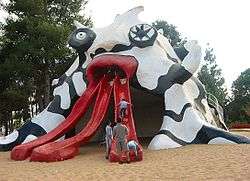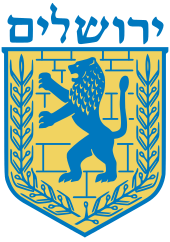Kiryat HaYovel

Kiryat HaYovel (Hebrew קריית היובל) is a neighborhood in southwestern Jerusalem on Mount Herzl. It was built in the early 1950s to house new immigrants. Today, Kiryat HaYovel has a population of 25,000 residents.
Kiryat HaYovel is located on the main road to Hadassah Hospital, Ein Kerem, between Ramat Denya and Kiryat Menachem.[1]
History

Kiryat HaYovel was established in the 1952 to house thousands of Jews from Arab countries who fled their homes when the State of Israel was declared. In the early days it was a tent city, as public housing projects, called shikunim, were hastily built to accommodate them. Before 1948, the area was known as Beit Mazmil. It was renamed Kiryat Hayovel (Jubilee Town) to commemorate the fiftieth anniversary of the Jewish National Fund.[2]
The need for housing was so urgent that a British mandatory ordinance requiring that all buildings in Jerusalem be faced with Jerusalem stone was waived in Kiryat Hayovel. Functional architecture, with flat roofs, stucco facades and no ornamentation, was characteristic of early construction in the neighborhood, and many examples remain until today.[3]
Demographics
The neighborhood's immigrant population was gradually supplemented with young couples. In the 1960s, they were joined by teachers and professors, offsetting the proletarian character of the neighborhood and creating more upscale sections, such as the large private homes lining Shmaryahu Levin Street.[1] In 2002, it was described as a blue-collar neighborhood.[4]
Terrorist incidents

On March 29, 2002, Ayat al-Akhras, an 18-year-old Palestinian, blew herself up at the entrance of Kiryat HaYovel's main supermarket, killing two people and injuring 28.[5]
Culture
Kiryat HaYovel has a commercial center, a community center, three public swimming pools and a library.
The neighborhood's claim to fame is "The Golem", a whimsical playground sculpture set in Rabinovich Park. Commonly called "The Monster" (Hamifletzet in Hebrew), the sculpture's three red tongues serve as slides. The Golem was designed by the French sculptor Niki de Saint-Phalle.[6]
Many of the streets in Kiryat HaYovel are named for countries in Latin America, whose United Nations representatives voted in favor of the establishment of Israel in 1947.[7]
Hospitals
ALYN Hospital, a comprehensive rehabilitation center for physically challenged and disabled children, adolescents and young adults, is located in Kiryat HaYovel.[8]
Notable residents
- Teddy Kollek, mayor of Jerusalem 1965 to 1993
External links
| Wikimedia Commons has media related to Kiryat Hayovel. |
- Short fundraiser filmed in the neighborhood in the 1950s
- Kiryat HaYovel WebSite
- Jerusalem WebSite on Kiryat HaYovel
References
- 1 2 High stakes | Jerusalem Post
- ↑ Vilnai, Zeev (1972). The Guide to Israel. Hamakor Press. p. 111.
- ↑ Eldar, Yishai. "Jerusalem Architecture Since 1948". Retrieved 2008-09-04.
- ↑ MIDEAST TURMOIL: TERRORISM; Suicide Bomber, 18, Kills 2 Israelis and Herself
- ↑ "Israel Under Attack-Jerusalem-Kiryat Yovel". Israeli Prime Minister's Office. 2002-03-29. Retrieved 2007-09-04.
- ↑ ""The Golem" at Rabinovitch Park". The Jerusalem Foundation. 2002-08-20. Retrieved 2007-09-04.
- ↑ Simon, Griver (1999-04-01). "Whats in a street name? In Israel, a treasure trove of people, places and events.". Israel Ministry of Foreign Affairs. Retrieved 2007-09-04.
- ↑ "Where did we come from and where are we going to?". Alyn hospital. Retrieved 2007-09-04.
Coordinates: 31°45′27″N 35°10′40″E / 31.75750°N 35.17778°E
